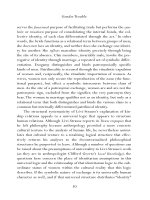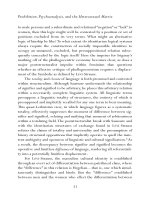GENDER TROUBLE 100
Bạn đang xem bản rút gọn của tài liệu. Xem và tải ngay bản đầy đủ của tài liệu tại đây (20.58 KB, 1 trang )
Prohibition, Psychoanalysis, and the Heterosexual Matrix
of mixed gender attributes in the “interplay of conflicts” (35). Significantly, she contrasts this kind of psychoanalytic theory with one that
would reduce the presence of ostensibly “masculine” attributes in a
woman to a “radical or fundamental tendency.” In other words, the
acquisition of such attributes and the accomplishment of a heterosexual
or homosexual orientation are produced through the resolution of conflicts that have as their aim the suppression of anxiety. Citing Ferenczi in
order to establish an analogy with her own account, Riviere writes:
Ferenczi pointed out . . . that homosexual men exaggerate their
heterosexuality as a ‘defence’ against their homosexuality. I shall
attempt to show that women who wish for masculinity may put on a
mask of womanliness to avert anxiety and the retribution feared
from men. (35)
It is unclear what is the “exaggerated” form of heterosexuality the
homosexual man is alleged to display, but the phenomenon under
notice here might simply be that gay men simply may not look much
different from their heterosexual counterparts. This lack of an overt
differentiating style or appearance may be diagnosed as a symptomatic
“defense” only because the gay man in question does not conform to
the idea of the homosexual that the analyst has drawn and sustained
from cultural stereotypes. A Lacanian analysis might argue that the
supposed “exaggeration” in the homosexual man of whatever attributes
count as apparent heterosexuality is the attempt to “have” the Phallus,
the subject position that entails an active and heterosexualized desire.
Similarly, the “mask” of the “women who wish for masculinity” can be
interpreted as an effort to renounce the “having” of the Phallus in order
to avert retribution by those from whom it must have been procured
through castration. Riviere explains the fear of retribution as the consequence of a woman’s fantasy to take the place of men, more precisely, of the father. In the case that she herself examines, which some
consider to be autobiographical, the rivalry with the father is not over
65









